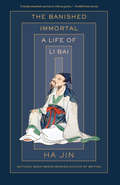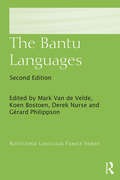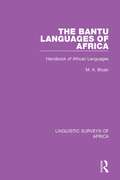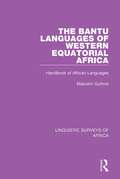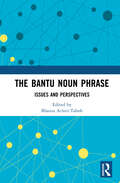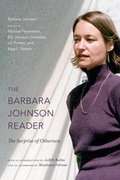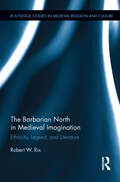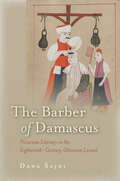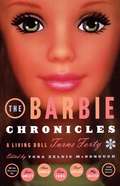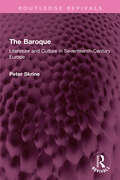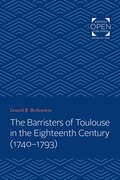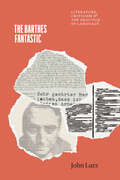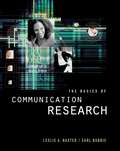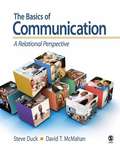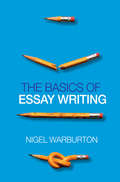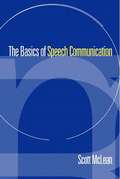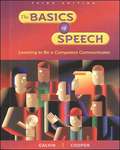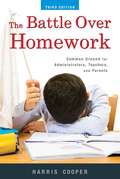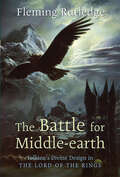- Table View
- List View
The Banished Immortal: A Life of Li Bai (Li Po)
by Ha JinFrom the National Book Award-winning author of Waiting: a narratively driven, deeply human biography of the Tang dynasty poet Li Bai—also known as Li PoIn his own time (701–762), Li Bai's poems—shaped by Daoist thought and characterized by their passion, romance, and lust for life—were never given their proper due by the official literary gatekeepers. Nonetheless, his lines rang out on the lips of court entertainers, tavern singers, soldiers, and writers throughout the Tang dynasty, and his deep desire for a higher, more perfect world gave rise to his nickname, the Banished Immortal. Today, Bai's verses are still taught to China's schoolchildren and recited at parties and toasts; they remain an inextricable part of the Chinese language.With the instincts of a master novelist, Ha Jin draws on a wide range of historical and literary sources to weave the great poet's life story. He follows Bai from his origins on the western frontier to his ramblings travels as a young man, which were filled with filled with striving but also with merry abandon, as he raised cups of wine with friends and fellow poets. Ha Jin also takes us through the poet's later years—in which he became swept up in a military rebellion that altered the course of China's history—and the mysterious circumstances of his death, which are surrounded by legend.The Banished Immortal is an extraordinary portrait of a poet who both transcended his time and was shaped by it, and whose ability to live, love, and mourn without reservation produced some of the most enduring verses.
The Bantu Languages (Routledge Language Family Series)
by Derek Nurse Koen Bostoen Mark Van De Velde Gérard PhilippsonWritten by an international team of experts, this comprehensive volume presents grammatical analyses of individual Bantu languages, comparative studies of their main phonetic, phonological and grammatical characteristics and overview chapters on their history and classification. It is estimated that some 300 to 350 million people, or one in three Africans, are Bantu speakers. Van de Velde and Bostoen bring together their linguistic expertise to produce a volume that builds on Nurse and Philippson’s first edition. The Bantu Languages, 2nd edition is divided into two parts; Part 1 contains 11 comparative chapters, and Part 2 provides grammar sketches of 12 individual Bantu languages, some of which were previously undescribed. The grammar sketches follow a general template that allows for easy comparison. Thoroughly revised and updated to include more language descriptions and the latest comparative insights. New to this edition: • new chapters on syntax, tone, reconstruction and language contact • 12 new sketch grammars • thoroughly updated chapters on phonetics, aspect-tense-mood and classification • exhaustive catalogue of known languages with essential references This unique resource remains the ideal reference for advanced undergraduate and postgraduate students of Bantu linguistics and languages. It will be of interest to researchers and anyone with an interest in historical linguistics, linguistic typology and grammatical analysis.
The Bantu Languages of Africa: Handbook of African Languages (Linguistic Surveys of Africa #17)
by M. A. BryanThe area covered by this book, originally published in 1953, is one that has long been recognized as presenting many problems from the point of view of Bantu linguistic studies. Almost all the material set out in this present work is based on notes taken in the field, and in many cases presented completely new facts. The sources of the information used are listed at the end of the linguistic description of each of the groups of languages dealt with. Since there are so many languages to be covered it would be impracticable to give even an outline of the main features of each of them, so an outline is given of the main characteristics of each separate group. One language is used as the type for each group, for the purpose of listing examples of the nominal prefixes, verbal conjugation, and personal prefixes. Other features are illustrated from whichever language is the most suitable.
The Bantu Languages of Western Equatorial Africa: Handbook of African Languages (Linguistic Surveys of Africa #16)
by Malcolm GuthrieThe area covered by this book, originally published in 1953, is one that has long been recognized as presenting many problems from the point of view of Bantu linguistic studies. Almost all the material set out in this present work is based on notes taken in the field, and in many cases presented completely new facts. The sources of the information used are listed at the end of the linguistic description of each of the groups of languages dealt with. Since there are so many languages to be covered it would be impracticable to give even an outline of the main features of each of them, so an outline is given of the main characteristics of each separate group. One language is used as the type for each group, for the purpose of listing examples of the nominal prefixes, verbal conjugation, and personal prefixes. Other features are illustrated from whichever language is the most suitable.
The Bantu Noun Phrase: Issues and Perspectives
by Blasius Achiri-TabohThis collection of original essays addresses salient issues in a range of empirical and conceptual analyses, providing detailed case studies of phenomena in Bantu languages and robust and interesting discussions on the structure of the noun phrase. This volume speaks to contemporary debates on the Bantu noun phrase, seeking to stimulate a greater understanding of the true nature of adnominal modification, definiteness, and anaphoric relations associated with it, with respect to various segmental and supra-segmental, noun formation, and noun classification phenomena. The ten chapters take the reader through the Grassfields, North-Western, North-Eastern and Southern present-day Bantu homeland, making important contributions to the documentation and analysis of Bantu languages. The Bantu Noun Phrase: Issues and Perspectives is unique in its inclusion of so many North-Eastern Bantu languages in its discourse on Bantu linguistics and this important collection will be of particular interest to those researching, teaching, and studying African languages and linguistics.
The Barbara Johnson Reader: The Surprise of Otherness
by Barbara Johnson Keja L. Valens Lili Porten Bill Johnson González Melissa GonzálezThis Reader collects in a single volume some of the most influential essays written by Barbara Johnson over the course of her thirty-year career as a pioneering literary theorist and cultural critic. Johnson achieved renown early in her career, both as a brilliant student of the Yale School of literary criticism and as the translator of Jacques Derrida's Dissemination. She went on to lead the way in extending the insights of structuralism and poststructuralism into newly emerging fields now central to literary studies, fields such as gender studies, African American studies, queer theory, and law and literature. Stunning models of critical reading and writing, her essays cultivate rigorous questioning of universalizing assumptions, respect for otherness and difference, and an appreciation of ambiguity.Along with the classic essays that established her place in literary scholarship, this Reader makes available a selection of Johnson's later essays, brilliantly lucid and politically trenchant works exploring multilingualism and translation, materiality, ethics, subjectivity, and sexuality. The Barbara Johnson Reader offers a historical guide through the metamorphoses and tumultuous debates that have defined literary study in recent decades, as viewed by one of critical theory's most astute thinkers.
The Barbarian North in Medieval Imagination: Ethnicity, Legend, and Literature (Routledge Studies in Medieval Religion and Culture)
by Robert RixThis book examines the sustained interest in legends of the pagan and peripheral North, tracing and analyzing the use of an ‘out-of-Scandinavia’ legend (Scandinavia as an ancestral homeland) in a wide range of medieval texts from all over Europe, with a focus on the Anglo-Saxon tradition. The pagan North was an imaginative region, which attracted a number of conflicting interpretations. To Christian Europe, the pagan North was an abject Other, but it also symbolized a place from which ancestral strength and energy derived. Rix maps how these discourses informed ‘national’ legends of ancestral origins, showing how an ‘out-of-Scandinavia’ legend can be found in works by several familiar writers including Jordanes, Bede, ‘Fredegar’, Paul the Deacon, Freculph, and Æthelweard. The book investigates how legends of northern warriors were first created in classical texts and since re-calibrated to fit different medieval understandings of identity and ethnicity. Among other things, the ‘out-of-Scandinavia’ tale was exploited to promote a legacy of ‘barbarian’ vigor that could withstand the negative cultural effects of Roman civilization. This volume employs a variety of perspectives cutting across the disciplines of poetry, history, rhetoric, linguistics, and archaeology. After years of intense critical interest in medieval attitudes towards the classical world, Africa, and the East, this first book-length study of ‘the North’ will inspire new debates and repositionings in medieval studies.
The Barbarism of Berlin
by G. K. ChestertonUnless we are all mad, there is at the back of the most bewildering business a story: and if we are all mad, there is no such thing as madness. If I set a house on fire, it is quite true that I may illuminate many other people's weaknesses as well as my own. It may be that the master of the house was burned because he was drunk: it may be that the mistress of the house was burned because she was stingy, and perished arguing about the expense of a fire-escape. It is, nevertheless, broadly true that they both were burned because I set fire to their house. That is the story of the thing. The mere facts of the story about the present European conflagration are quite as easy to tell. -- G.K. Chesterton
The Barber of Damascus: Nouveau Literacy in the Eighteenth-Century Ottoman Levant
by Dana SajdiThis book is about a barber, Shihab al-Din Ahmad Ibn Budayr, who shaved and coiffed, and probably circumcised and healed, in Damascus in the 18th century. The barber may have been a "nobody," but he wrote a history book, a record of the events that took place in his city during his lifetime. Dana Sajdi investigates the significance of this book, and in examining the life and work of Ibn Budayr, uncovers the emergence of a larger trend of history writing by unusual authors—people outside the learned establishment—and a new phenomenon: nouveau literacy. The Barber of Damascus offers the first full-length microhistory of an individual commoner in Ottoman and Islamic history. Contributing to Ottoman popular history, Arabic historiography, and the little-studied cultural history of the 18th century Levant, the volume also examines the reception of the barber's book a century later to explore connections between the 18th and the late 19th centuries and illuminates new paths leading to the Nahda, the Arab Renaissance.
The Barbie Chronicles
by Yona Zeldis McdonoughA THOROUGHLY GROWN-UP LOOK AT A TWENTIETH-CENTURY MUSE OF OUTSTANDING PROPORTIONS To some she's a collectible, to others she's trash. In The Barbie Chronicles, twenty-three writers join together to scrutinize Barbie's forty years of hateful, lovely disastrous, glorious influence on us all. No other tiny shoulders have ever, had to carry the weight of such affection and derision and no other book has ever paid this notorious little place of plastic her due. Whether you adore her or abhor her, The Barbie Chronicles will have you looking at her in ways you never imagined.
The Barn Raising
by Ashley Wolff Nancy FurstingerThe fun and excitement of English and Language Arts learning continues in Grade 2 of Reading Street. This comprehensive and dynamic curriculum for homeschooling is geared toward young children who have some foundational English and Language Arts knowledge and are ready to strengthen their skills. Comprised of engaging activities, challenging content and weekly quizzes, Reading Street: Grade 2 is the next step in your child's path toward becoming a lifelong learner and reader. As with all Reading Street products, the Grade 2 system is formatted to help students meet certain age-appropriate goals. After completing this English and Language Arts homeschool program, your child should be able to: Read and comprehend two-syllable words. Identify common prefixes (such as pre-, un-, or re-) and suffixes (such as -able, -ad and -er). Correct mistakes made when reading out loud. Read books with two or more chapters. Understand the structure of stores (i. e. beginning, middle and end). Start selecting reading materials based on his/her own interests. Identify the "who," "what," "when," "where," "why" and "how" of the text. While the goals of second Grade English and Language Arts are numerous, Reading Street will help you craft engrossing lessons. Your child will garner important English and Language Arts skills while completing a workbook, reading stories and poems, and taking assessments. Planning these lessons will be easier than ever, as all Reading Street systems are broken down into weekly Big Ideas. All the work your child does on a given week is formulated around that single concept for an organized and challenging curriculum. With six easy-to-follow units, Reading Street: Grade 2 is the perfect tool for homeschooling parents. Your child will enjoy the reading selections and activities, and you'll love to see your student growing into a knowledgeable individual. We're confident that this product is the right one for you. For more information on the specific materials found in Grade 2 of Reading Street, check out the Features and Benefits page.
The Baroque: Literature and Culture in Seventeenth-Century Europe (Routledge Revivals)
by Peter N. SkrineFirst Published in 1978, The Baroque focuses on eight areas where it expressed itself most successfully. The cultural movement called baroque dominated most of the Western Europe from the late sixteenth century to the 1720s. During that long time, it went through various phases, affecting some arts, some countries more than others. There are many overlapping definitions of baroque like from a mode of European painting to a style of architecture or rather a cultural phenomenon which manifested itself most noticeably in the fine and applied arts. In this book each chapter presents a separate exploration of different interlinked facets of this vast and maze-like subject. This book is an interesting read for scholars of European literature.
The Barristers of Toulouse in the Eighteenth Century (The Johns Hopkins University Studies in Historical and Political Science)
by Lenard BerlansteinOriginally published in 1975. Following the vein of French historiography, many twentieth-century scholars of the French Revolution believed that the middle class of lawyers played a crucial role in the Revolution. In The Barristers of Toulouse, Lenard Berlanstein contends with that notion in a case study examining the response of the Toulousian legal community to the French Revolution. Using tax rolls, marriage contracts, and court records as primary sources, Professor Berlanstein argues that class interests—such as a desire to preserve their status in the cultured, conservative urban elite—led many Toulousian judges and lawyers to reject the Revolution and to remain loyal to the aristocratic Parlement. In other words, those in the legal community of Toulouse conducted themselves in ways that were consistent with other members of their social and economic class. To supplement his argument, Berlanstein's integrates methods from the New Social History movement.
The Barthes Fantastic: Literature, Criticism, and the Practice of Language (Thinking Literature)
by John LurzThis study of the writing of Roland Barthes breaks down the divide between lived experience and the language of a literary work. In The Barthes Fantastic, John Lurz explores the intersection of literature and everyday life—and confronts some habits of literary study—through a reading of the work of Roland Barthes. An influential French theorist, Barthes wrote prolifically on the place of language and the play of signs in the ways we produce cultural and aesthetic meaning. Ranging across the entire sweep of Barthes’s varied career, Lurz shows how Barthes’s insights into signification and literature involve particular intellectual activities that impart significance to the world. Doing so allows him to develop an expanded understanding of the fantastic as a conceptual category—a way of thinking—in which the texts we read come to inform the texture of our real lives. Ultimately, The Barthes Fantastic enlarges our sense of what we learn as students of literature and gives us a new picture of a writer we thought we knew.
The Basics of Communication Research
by Leslie A. Baxter; Earl BabbieCombining the time tested classical work of Earl Babbie with the insights of one of the most recognized and respected names in speech communication research, THE BASICS OF COMMUNICATION RESEARCH is the book for the Communication research methods course. With the authors' collective experience teaching research methods and as active researchers themselves you will find this text to be the authoritative text for your course. The authors frame research as a way of knowing, and provide balanced treatment to both quantitative and qualitative research traditions in communication research and present it in a student friendly and engaging format. It provides in-depth treatment of the role of reasoning in the research enterprise and how this reasoning process plays itself out in planning and writing a research proposal and report.
The Basics of Communication: A Relational Perspective
by Steve Duck David T. McmahanThis introductory communication textbook explores fundamental communication concepts, theories, skills, and contexts with a thematic integration to everyday life that allows all of these things to cohere and offers an engaging look at the inseparable connection between relationships and communication, highlighting the roles that interpersonal connections play in casual discussions as well as in public speaking.
The Basics of English Usage
by Wynford HicksShould I say "He is taller than I" or "He is taller than me?" Do you spell it "blond" or "blonde"? If you’ve ever been stopped in your tracks by questions like these, then this book is for you. A complete pocket guide to the ins and outs of everyday English, The Basics of English Usage will tell you all you need to know about such topics as: correct spelling good grammar and style punctuation and how to use it problem words that everyone gets wrong. Including guides to further reading and online resources, The Basics of English Usage is an indispensable survival guide for anyone wanting to improve their writing and communication.
The Basics of Essay Writing
by Nigel WarburtonNigel Warburton, bestselling author and experienced lecturer, provides all the guidance and advice you need to dramatically improve your essay-writing skills. The book opens with a discussion of why it is so important to write a good essay, and proceeds through a step-by-step exploration of exactly what you should consider to improve your essays and marks.You will find help on how to:focus on answering the question askedresearch and plan your essaybuild and sustain an argumentimprove your writing style and tone.The Basics of Essay Writing is packed full of good advice and practical exercises. Students of all ages and in every subject area will find it an easy-to-use and indispensable aid to their studies.
The Basics of Media Writing: A Strategic Approach
by Scott A. Kuehn James Andrew LingwallThe Basics of Media Writing: A Strategic Approach helps readers develop the essential writing skills and professional habits needed to succeed in 21st-century media careers. This research-driven, strategy-based media writing textbook digs deeply into how media professionals think and write in journalism, public relations, advertising, and other forms of strategic communication. Authors Scott A. Kuehn and Andrew Lingwall have created two comprehensive writing models to help students overcome their problems in finding and developing story topics by giving them “starting points” to begin writing. The Professional Strategy Triangle model shows students how to think critically about the audience, the situation, and the message before starting a news story or persuasive piece and the FAJA four-point model asks students a series of questions about their story type (Fact, Analysis, Judgment, or Action) to guide them to the right angle or organizational structure for their message. Rooted in classical rhetorical methods, this step-by-step technique enables readers to strategically approach each writing task, no matter the format.
The Basics of Media Writing: A Strategic Approach
by Scott A. Kuehn James Andrew LingwallThe Basics of Media Writing: A Strategic Approach helps readers develop the essential writing skills and professional habits needed to succeed in 21st-century media careers. This research-driven, strategy-based media writing textbook digs deeply into how media professionals think and write in journalism, public relations, advertising, and other forms of strategic communication. Authors Scott A. Kuehn and Andrew Lingwall have created two comprehensive writing models to help students overcome their problems in finding and developing story topics by giving them “starting points” to begin writing. The Professional Strategy Triangle model shows students how to think critically about the audience, the situation, and the message before starting a news story or persuasive piece and the FAJA four-point model asks students a series of questions about their story type (Fact, Analysis, Judgment, or Action) to guide them to the right angle or organizational structure for their message. Rooted in classical rhetorical methods, this step-by-step technique enables readers to strategically approach each writing task, no matter the format.
The Basics of Speech Communication
by Scott McleanAn introduction to terms, concepts and theory of speech communication.
The Basics of Speech: Learning to Be a Competent Communicator (3rd Edition)
by Kathleen M. Galvin Pamela J. CooperThe Basics of Speech addresses a very important skill--communication. This introductory text addresses interpersonal and group communication, public speaking, debate, parliamentary procedure, and oral interpretation. Based on the concept that oral communication is a skill learned by doing, students are involved in thinking and expressing themselves from the first to the last chapter.
The Battle Over Homework: Common Ground for Administrators, Teachers, and Parents (Roadmaps To Success Ser.roadmaps To Success Series)
by Harris M. CooperHomework is the cause of more friction between schools and home than any other aspect of education and becomes the prime battlefield when schools, families, and communities view one another as adversaries. This comprehensive fourth edition tackles all the tough questions: What’s the right amount of homework? What role should parents play in the homework process? What is the connection between homework and achievement?This essential reference offers all stakeholders-administrators, teachers, and parents-the opportunity to end the battle and turn homework into a cooperative endeavor to promote student learning.
The Battle for Middle-earth: Tolkien's Divine Design in The Lord of the Rings
by Fleming RutledgeJ. R. R. Tolkien's Lord of the Rings has long been acknowledged as the gold standard for fantasy fiction, and the recent Oscar-winning movie trilogy has brought forth a whole new generation of fans. Many Tolkien enthusiasts, however, are not aware of the profoundly religious dimension of the great Ring saga. In The Battle for Middle-earth Fleming Rutledge employs a distinctive technique to uncover the theological currents that lie just under the surface of Tolkien's epic tale. Rutledge believes that the best way to understand this powerful "deep narrative" is to examine the story as it unfolds, preserving some of its original dramatic tension. This deep narrative has not previously been sufficiently analyzed or celebrated. Writing as an enthusiastic but careful reader, Rutledge draws on Tolkien's extensive correspondence to show how biblical and liturgical motifs shape the action. At the heart of the plot lies a rare glimpse of what human freedom really means within the Divine Plan of God. The Battle for Middle-earth surely will, as Rutledge hopes, "give pleasure to those who may already have detected the presence of the sub-narrative, and insight to those who may have missed it on first reading."
